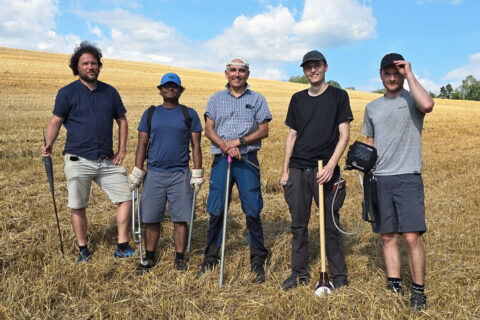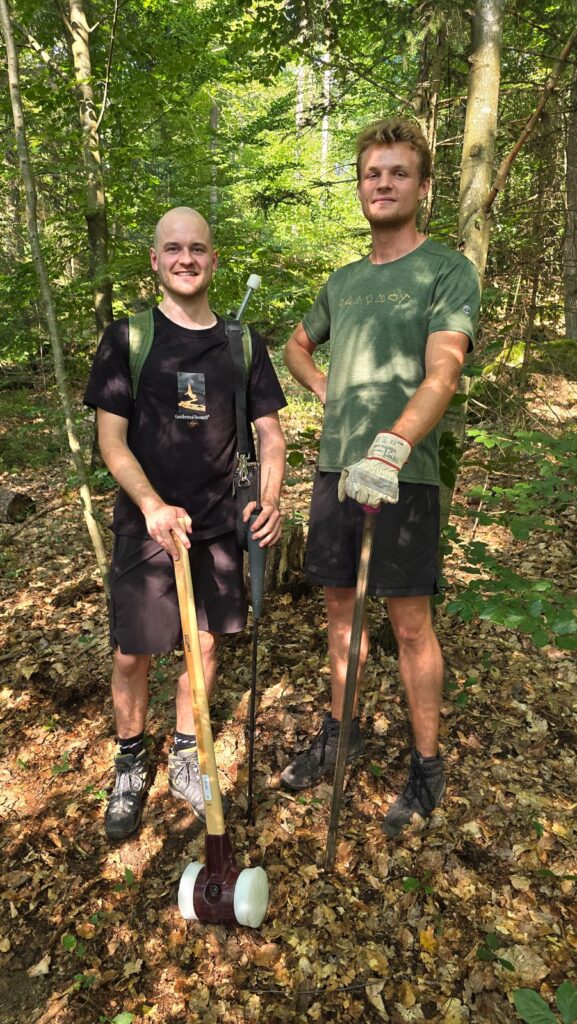Natural hydrogen – the treasure hidden underground

Favorable geological conditions in northern Bavaria
Will natural hydrogen be a bearer of hope in the energy transition?
The race to find this valuable gas underground is gaining speed and GeoZentrum Nordbayern at FAU is one of the institutions at the forefront of this race. The research project “Natural hydrogen in northern Bavaria” has supplied initial measurements that could revolutionize the energy system of the future.
Felix Gsell and Julius Liebermann, students of the Master’s degree program GeoThermics/GeoEnergy, haven’t got it easy: Using soil air measurements they investigate whether hydrogen is present in areas in the field they have carefully chosen in advance – the method may be simple, but it’s physically demanding. With a hammer, the students drive a meter-long thin drill rod into the earth, which is later removed with all the stones and soil material. They then insert a probe into the borehole that simultaneously seals it to protect it against contamination from air in the atmosphere. The last step is where Felix and Julius connect the probe to a mobile hydrogen sensor and pump out the air from one meter below the surface.
A sensational discovery
All the effort has paid off: At the beginning of August 2024, Felix made a note of the first measurement of 1000 ppm of hydrogen – a value at the upper measurement limit of the sensor. Such a high value for soil air measurements has not been previously documented in specialist literature and was quite a sensational discovery. At first, Felix couldn’t quite believe it. “It was a mixture of relief that I hadn’t wasted all those months in the field without detecting anything and doubt as to whether the high values were actually genuine,” says the Master’s student. His doubts soon disappeared, however. Since then, as well as measurements showing little or no hydrogen, they have obtained several measurements with values above 1000 ppm. Project manager Dr. Jürgen Grötsch, lecturer at the Chair of Geology of Prof. Dr. Harald Stollhofen, reiterates Felix’s discovery: The high measurement values of H2 confirm our assumption that there are commercially viable deposits of natural hydrogen in northern Bavaria.”
Grötsch is convinced that natural hydrogen could become an important component in our future energy system. “There are enough indications that deposits of hydrogen are hidden away in several regions in Germany and also worldwide that could supply clean energy. However, our current level of knowledge is very sketchy and characterized by a great deal of uncertainty. Our understanding of the mechanisms by which natural hydrogen is formed is at the level of that of hydrocarbon exploration 150 years ago.”
Natural hydrogen – building up a system out of a coincidence

We could, however, have already made more progress here. As early as 1910, the miner Ernst Erdmann happened to discover natural hydrogen at the Leopoldshall salt mine near Stassfurt and produced it for some years. Natural hydrogen was also discovered by chance when drilling for drinking water in Bourakébougou in Mali in 1987. However, it was in 2012 when the first commercial production and use for power generation in Mali began. In contrast to the past, it’s now time to take targeted action: “We want to take the coincidence out of previous finds and systematically investigate the conditions for the formation of natural hydrogen underground,” says Grötsch.
He has already identified two concepts in conjunction with his team. On the one hand, natural hydrogen is formed by radiolysis in granite bodies. On the other, ultrabasic rocks can also generate hydrogen when they come into contact with water and are exposed to high temperatures (200-350°C) underground during a mineral conversion process known as serpentinization. However, these are just two possibilities in a series of others that are already known such as “primordial hydrogen” known from exoplanetary research, which is hydrogen located in the core and the lower mantle, fixed in an early stage of planetary formation, that could also exist on Earth. It is still not known which of these methods of formation plays the most important role.
This is what Grötsch’s team hope to find out as part of a research consortium. In addition to members from GeoZentrum Nordbayern, it includes researchers from Fraunhofer IEG, RWTH Aachen, the Leibniz Institute for Applied Geophysics (LIAG), the Karlsruhe Institute of Technology (KIT), and the German Research Centre for Geosciences (GFZ).
The researchers at GeoZentrum Nordbayern will focus specifically on northern Bavaria. Should they discover sources of natural hydrogen, it is still not clear how these sources should be prospected and produced. This will be the subject of a pilot project in a second step. There are a series of hurdles to be overcome first, explains Grötsch. In contrast to France, for example, there is no legal framework for awarding hydrogen concessions in Germany, since natural hydrogen is not part of German mining law in the federal states. Technical expertise and financial funding is also required from the Federal Government and from the governments of the Länder. Chair of Geology Stollhofen thinks FAU is particularly well-positioned in terms of its expertise: “We have the know-how required at GeoZentrum Nordbayern and in other institutes at FAU to give hydrogen research a decisive boost and, in the long term, to make the hydrogen available to end users as clean energy.” And there are plenty of young researchers currently being trained as experts for the future: “For more than seven years, our Master’s degree program GeoThermics/GeoEnergy has been teaching students the skills they need to shape the energy transition to include sustainable energy carriers from underground. In addition to geothermal project development, research into natural hydrogen which has been long overlooked as an energy source is finally moving into the center of attention. And the geological conditions in northern Bavaria are favorable.”
FAU’s GeoZentrum Nordbayern